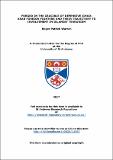Files in this item
Forged in the crucible of defensive jihad : Arab foreign fighters and their trajectory to involvement in Islamist terrorism
Item metadata
| dc.contributor.advisor | Lehr, Peter | |
| dc.contributor.advisor | McConaghy, Kieran | |
| dc.contributor.advisor | Marsden, Sarah V. | |
| dc.contributor.author | Warren, Roger Patrick | |
| dc.coverage.spatial | x, 295 p. | en_US |
| dc.date.accessioned | 2017-08-30T13:55:37Z | |
| dc.date.available | 2017-08-30T13:55:37Z | |
| dc.date.issued | 2017-07-18 | |
| dc.identifier.uri | https://hdl.handle.net/10023/11567 | |
| dc.description.abstract | This thesis challenges the conventional wisdom that tends to conflate Arab foreign fighters with Islamist terrorists, and ‘martyrdom operations’ with ‘suicide attacks.’ Overlaps notwithstanding, it aims to draw distinctions between Arab foreign fighters engaged in defensive jihad defending co-religionists against a military foe, and Islamist terrorists engaged in terrorism that indiscriminately targets civilians and non-combatants. Critically, while disaggregating the two transnational cohorts, this thesis also illuminates the nexus between them. It draws on a thesis dataset of 3,010 Arab foreign fighters compiled using biographies, martyrdom eulogies, and postings on ‘jihadi’ websites, in both English and Arabic. This dataset is then used to support three case studies involving the defensive jihads in 1980s Afghanistan, Iraq (post 2003), and Syria (post 2011). It leverages a theoretical framework based on the concept of radicalisation and the language of political Islam, whilst concurrently drawing on theories from psychology and historical military examples of combat, germane to defensive jihad and Islamist terrorism. The thesis concludes that Arab foreign fighters involved in defensive jihad employ martyrdom operations against military targets, through tactical necessity. Conversely, Islamist terrorists employ suicide attacks against civilians and non-combatants, through ideological necessity. The trajectory between the two transnational mobilisations appears to be broadly underpinned by facets of the Lucifer Effect – the situational factors encountered whilst participating in defensive jihad, including but not limited to, the experience of close combat in a war zone; being subjected to ideological indoctrination; and being exposed to charismatic authority and obedience to it. This suggests that subsequent involvement in Islamist terrorism by some Arab foreign fighters is primarily forged in the crucible of defensive jihad. Such findings should result in the crafting of more individualised de-radicalisation and rehabilitation programmes for returning foreign fighters, in both the West and the Arab world. | en_US |
| dc.language.iso | en | en_US |
| dc.publisher | University of St Andrews | |
| dc.subject | Arab foreign fighters | en_US |
| dc.subject | Radicalisation | en_US |
| dc.subject | Political Islam | en_US |
| dc.subject | Lucifer Effect | en_US |
| dc.subject | Defensive jihad | en_US |
| dc.subject | Charismatic authority and obedience | en_US |
| dc.subject | Ideological indoctrination | en_US |
| dc.subject.lcc | BP182.W2 | |
| dc.subject.lcsh | Jihad | |
| dc.subject.lcsh | Terrorism--Religious aspects--Islam | |
| dc.title | Forged in the crucible of defensive jihad : Arab foreign fighters and their trajectory to involvement in Islamist terrorism | en_US |
| dc.type | Thesis | en_US |
| dc.type.qualificationlevel | Doctoral | en_US |
| dc.type.qualificationname | PhD Doctor of Philosophy | en_US |
| dc.publisher.institution | The University of St Andrews | en_US |
| dc.publisher.department | The Centre for the Study of Terrorism and Political Violence (CSTPV) | en_US |
This item appears in the following Collection(s)
Items in the St Andrews Research Repository are protected by copyright, with all rights reserved, unless otherwise indicated.

